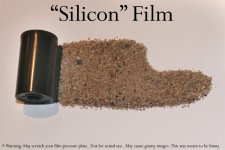jlw
Rangefinder camera pedant
Having read a lot about it at the time, my impression was that it was a legitimate project that simply ran into a lot of unanticipated problems and didn't pan out. I think most of the scam/hoax reaction came from consumers who had gotten their hopes up and were frustrated when those hopes were dashed.
Here's a link (click here) to a 2002 writeup on Imaging Resource that gives a good summary of the original project and the problems it encountered. I had forgotten that they DID eventually get a few working prototype units to the press, and that FCC certification was a major hurdle they didn't solve.
The writeup also makes a good point (even in 2002) that part of the appeal of the original idea was that there were no moderate-priced DSLRs available when the talk first started, so photographers were hungry for an alternative.
Now, five years later, with scads of very capable DSLRs available at prices many photographers can afford, I suspect the "silicon film" window of opportunity has closed -- unless some mass-market developer could come up with a version that would be cheap enough for casual experimenters.
Here's a link (click here) to a 2002 writeup on Imaging Resource that gives a good summary of the original project and the problems it encountered. I had forgotten that they DID eventually get a few working prototype units to the press, and that FCC certification was a major hurdle they didn't solve.
The writeup also makes a good point (even in 2002) that part of the appeal of the original idea was that there were no moderate-priced DSLRs available when the talk first started, so photographers were hungry for an alternative.
Now, five years later, with scads of very capable DSLRs available at prices many photographers can afford, I suspect the "silicon film" window of opportunity has closed -- unless some mass-market developer could come up with a version that would be cheap enough for casual experimenters.


